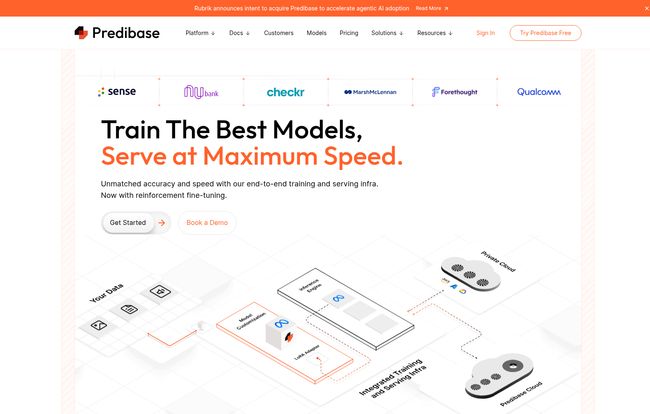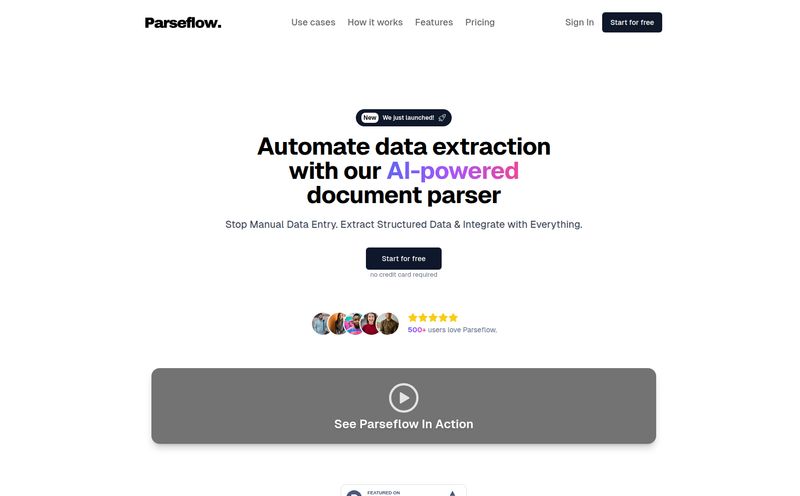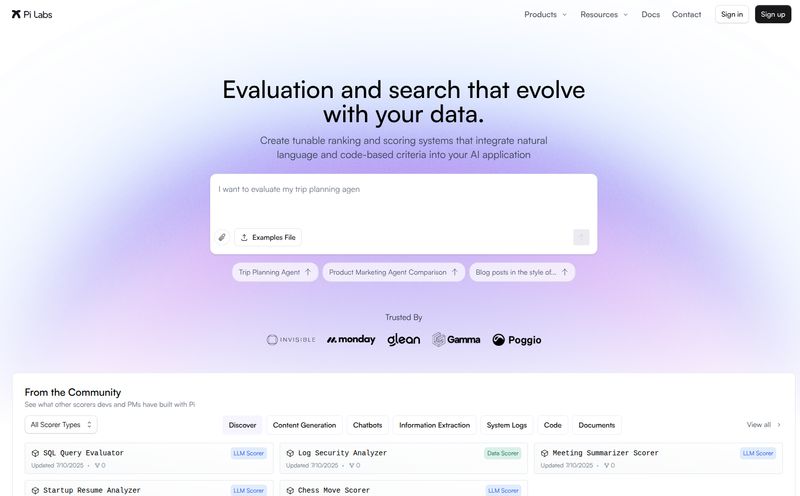The AI space is loud right now. Deafeningly so. Every other week, a new platform emerges from the woodwork, screaming about how it's going to revolutionize everything with its next-gen, paradigm-shifting, buzzword-laden model. As someone who’s been neck-deep in traffic generation and tech trends for years, my hype meter is pretty well-calibrated. It takes a lot to get me genuinely excited.
But then I stumbled upon Predibase. And I have to admit, my curiosity was piqued. Their promise isn't about creating a new foundational model to end all models. Instead, they’re focused on something far more practical, and frankly, far more useful for most businesses: making it ridiculously easy to take powerful, existing open-source models and customize them for your own needs. All without needing a PhD in machine learning or a dedicated team of DevOps engineers on speed dial.
So, is it just another drop in the AI ocean, or is this the tool that finally democratizes custom AI for the rest of us? Let's get into it.

Visit Predibase
So, What is Predibase, Really? (Beyond the Marketing Spiel)
At its core, Predibase is a low-code AI platform. Think of it like Webflow or Squarespace for building AI models. Instead of writing hundreds or thousands of lines of complex code to train, fine-tune, and deploy a model, Predibase lets you do it with just a handful. It’s built on top of some really smart open-source projects like Ludwig and Horovod (created by Predibase's founders at Uber), which is a good sign—they’re not reinventing the wheel, they’re just building a much better car around it.
The main event here is their focus on Large Language Models (LLMs). While you can use an API from a giant like OpenAI, you're stuck using their model, their way, at their price. Predibase’s whole philosophy is different. They give you the keys to powerful open-source models (think Llama 3, Mixtral, etc.) and the tools to make them uniquely yours. You can then serve these custom models from your own cloud or theirs. It’s about control, customization, and cost-efficiency. A trifecta we don't see often enough.
The Features That Actually Matter
A feature list is just a list until you understand the problems it solves. And let’s be real, building and serving custom AI has a lot of problems.
Fine-Tuning Made… Simple? The Low-Code Promise
This is the headline act. Predibase claims you can train a model with 1,000 times less data than traditional methods. That's a bold claim. For anyone who's tried to scrape together a massive, high-quality dataset, you know that's a game-changer. Their platform simplifies the process of fine-tuning, allowing you to adapt a powerful base model to your specific domain or task—like a customer support chatbot that actually knows your product inside and out.
Serving Models Without the DevOps Nightmare
Okay, so you’ve fine-tuned a model. Great. Now you have to serve it. This is often where projects go to die. Managing GPU infrastructure, handling scaling, and ensuring low latency is a full-time job. It’s like building a custom race car engine in your garage only to realize you have no chassis, wheels, or racetrack. Predibase handles this with what they call Multi-LoRA inference. In layman’s terms, it allows them to serve hundreds of different fine-tuned models on a single GPU, which drastically cuts down on cost. Their serverless infrastructure automatically scales up and down, so you’re not paying for idle GPUs. It's the kind of managed service that makes CTOs sleep better at night.
A Quick Word on RFT (Reinforcement Fine-Tuning)
This one's a bit more in the weeds, but it's important. Most fine-tuning happens with a static dataset. With Reinforcement Fine-Tuning, you can continue to improve your model based on actual user interactions and feedback. It creates a learning loop. Think of it as teh difference between studying from a textbook and having a conversation with a tutor who corrects you as you go. This leads to models that get smarter and more accurate over time, which is the holy grail for product-facing AI.
Predibase vs. The 800-Pound Gorilla: OpenAI
It’s the inevitable comparison. Why not just use GPT-4? For many, that's still the right answer. It’s fast, powerful, and easy to get started with. But Predibase is playing a different game. It’s for when you need more than what a general-purpose API can give you.
"Using a generic model like GPT-4 for a specialized task is like using a Swiss Army knife to perform surgery. It might work in a pinch, but you really want a scalpel. Predibase helps you forge that scalpel."
The main arguments for Predibase are cost and control. According to their own benchmarks, serving a fine-tuned open-source model on their platform can be significantly cheaper and faster than using OpenAI’s top-tier models. Plus, you own the model. It lives in your cloud environment (if you choose the VPC option), giving you full control over your data and security. For any company in a regulated industry like finance or healthcare, that’s not a nice-to-have; it’s a requirement.
The Money Talk: Breaking Down Predibase Pricing
Alright, let's talk turkey. Pricing for platforms like this can be a maze. Predibase is surprisingly transparent, though you still have to dig a bit. Here’s my breakdown of their model, as of writing this.
They essentially have three tiers:
- Free Tier: This is your playground. It includes free credits for fine-tuning and inference, access to shared GPUs, and community support. It's genuinely useful for testing the waters and seeing if the platform works for your use case. You can't complain about free.
- Enterprise Plan: This is the classic “talk to sales” plan. It’s for serious production workloads. You get dedicated infrastructure, premium support, private model registries, and all the security and compliance features a large organization needs. The price is bespoke, which always makes me sigh, but it's standard practice for this level of service.
- Virtual Private Cloud (VPC): This is the big one. Predibase deploys their entire platform inside your own cloud account (AWS, GCP, etc.). You get all the benefits of their software with the security and data governance of your own infrastructure. This is the ultimate control play.
What I find really interesting is their detailed breakdown of serverless costs. They publish their per-hour rates for different GPUs and even the cost per 1M tokens for fine-tuning and inference on popular models. For example, fine-tuning a Llama-3-8B-Instruct model costs about $1.00 per 1 million tokens. This level of transparency lets you actually run a cost-benefit analysis before you even sign up. More of this, please.
They also have a self-serve, pay-as-you-go tier in early access, which should be generally available later this year. That could be the sweet spot for many small-to-medium businesses.
| Tier | Best For | Key Feature |
|---|---|---|
| Free | Individuals, Testing, Small Projects | Free credits to experiment |
| Enterprise | Large Teams, Production Workloads | Dedicated support & infrastructure |
| VPC | Regulated Industries, Max Control | Runs in your own cloud |
My Two Cents: The Good, The Bad, and The Complicated
No tool is perfect. After digging through their docs and playing around, here’s my honest take. The biggest pro is the sheer speed and efficiency it brings to a notoriously slow and expensive process. The idea of taking an open-source model and having a fine-tuned, auto-scaling endpoint up and running in a day is incredible. It lowers the barrier to entry for creating truly differentiated AI products.
On the con side, there’s still a learning curve. While it's “low-code,” it’s not “no-code.” You still need to be a developer or data scientist who understands the fundamentals of what you're trying to do. And while the pay-as-you-go tier is coming, the current focus on Enterprise and VPC might make it feel out of reach for smaller startups right now.
The acquisition announcement by Rubrik also adds an interesting wrinkle. This could mean deeper integration into security and data management platforms, which is a huge plus. Or, it could mean changes in focus and pricing down the line. Something to keep an eye on.
So, What's the Verdict?
I started this with a healthy dose of skepticism, but I'm walking away impressed. Predibase isn't trying to be the flashiest player in the AI game. It’s trying to be one of the most useful. It addresses the real, unglamorous, and expensive problems of MLOps for modern AI.
It's not for the absolute beginner looking to ask an AI to write a poem. It’s for the builders, the developers, and the businesses that have hit the limits of generic APIs and are ready to build something unique. They're handing you that pre-built race car engine we talked about, fully tunable and ready to drop into your project. For the right team, that’s not just a time-saver; it’s the difference between shipping a product and being stuck in development hell.
Frequently Asked Questions
- What is Predibase used for?
- Predibase is primarily used by developers and data scientists to easily fine-tune, manage, and deploy open-source AI models, especially large language models (LLMs), for custom business applications.
- Is Predibase better than OpenAI?
- It's different. OpenAI offers a powerful, general-purpose model via an API. Predibase gives you the tools to customize and host your own models, offering more control, potential cost savings for specialized tasks, and better data privacy.
- How much does Predibase cost?
- It has a Free Tier for testing, a custom-priced Enterprise Plan for large-scale use, and a VPC option. They also publish detailed per-use costs for serverless inference and fine-tuning. A pay-as-you-go plan is also on the way.
- Can I use Predibase in my own cloud?
- Yes, their Virtual Private Cloud (VPC) offering allows you to deploy the entire Predibase platform within your own AWS or GCP account, giving you maximum security and control.
- Is Predibase beginner-friendly?
- It's 'low-code', not 'no-code'. It's designed for users with some technical background, like software engineers or data scientists. It simplifies complex processes but isn't a point-and-click tool for non-technical users.
- What is Multi-LoRA serving?
- It's a technology Predibase uses that allows many different fine-tuned models to be served efficiently from a single GPU. This significantly reduces the cost of hosting multiple custom models compared to dedicating a GPU to each one.



